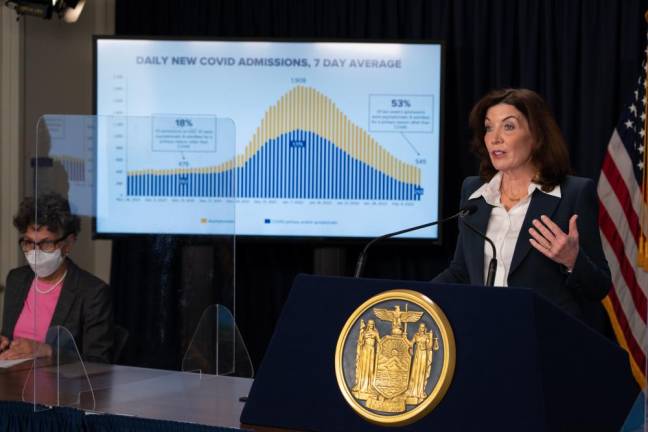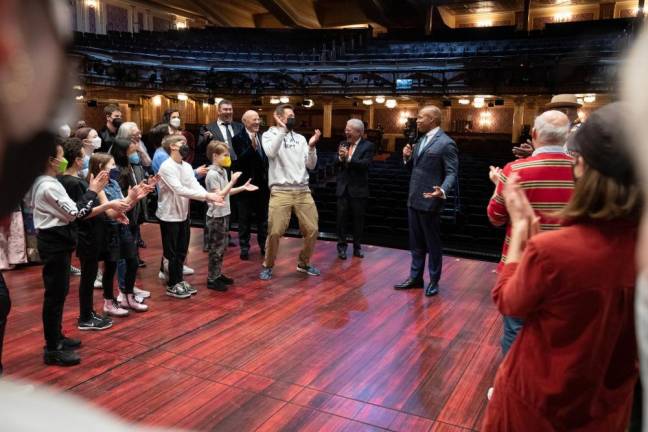Governor Kathy Hochul made it clear she was following more than just the science.
“Everybody I could think of received a phone call from me,” the governor explained.
Yes, her call list included Dr. Anthony Fauci and other scientists and health experts. But also included were Mayor Eric Adams and other local government officials, business people, educators and labor leaders, “to ask them how they feel about where we are, where we are going and what we should be doing next.”
The immediate result of the governor’s telephonic pulse-taking was the end of the statewide mandate to mask in restaurants, stores and other indoor settings, which the governor allowed to expire Thursday. Hochul was one of the wave of blue state governors who moved almost in unison to lift various mask-related restrictions.
“We are now approaching a new phase in this pandemic,” the governor said as she announced her decision.
Obvious but unspoken was that a defining characteristic of this new phase will be governments, and Democratic-led governments in particular, searching for the sustainable balance between restrictions that at least some public health experts think are still necessary and the public’s increasing exhaustion with those restrictions.
“I keep saying to myself, ‘I hope this is the right decision,’” said Professor Denis Nash of the City University’s School of Public Health. “My gut tells me it’s a little bit too soon for New York City.”
“Moving the Goalposts”
Part of the dilemma is that two years into the pandemic governments never really agreed on a clear set of metrics for judging when various restrictions should be eased. “It is like a moving the goalposts kind of thing,” said Nash, whose firm, Epidemic Intelligence, advises companies and institutions on COVID safety measures.
Hochul, for example, celebrated the sharply falling rate of COVID-19 in the state in announcing the end of the mask mandate. But only by looking closely at her graphs could you notice that case rates were still what the Centers for Disease Control characterizes as high, and well above where they were as recently as last fall.
“If you just look objectively at how much COVID is out there,” said Nash, “it’s trending in the right direction, but there it is still a lot of COVID.”
Which may be part of the reason that Hochul introduced a new piece of data never highlighted before in the various COVID-19 dashboards offered by city, state and federal health authorities.
This metric, which she said had been pointed out to her by Fauci, was the proportion of those infected with COVID-19 who end up in the hospital.
Last summer 6.2% of those infected with the then prevalent Delta variant were hospitalized. In January, only 3.5% of those infected with the now ubiquitous Omicron had to be hospitalized.
It is surely correct to introduce this new data, since it helps quantify the reduced risk that seems to result from wider vaccination and the less virulent variant. Indeed, Nash recommends following a related metric, the availability of the new antiviral and antibody medications, which are effective at preventing severe illness when administered quickly after infection with COVID-19.
But for some experts the search for purely data-driven solutions to the hard pandemic choices has proven fruitless. “It has become clear to me that decisions about restrictions cannot be solely determined by any single metric or combination of them,” Dr. Jay Varma wrote in the New York Times on Saturday.
A former health adviser to Bill de Blasio, Varma was appointed last week to a COVID recovery task force created by the new Manhattan Borough President, Mark Levine.
Varma recalled how de Blasio had closed in-person public schools in November of 2020 because he had said he would if the citywide positivity rate went above 3 percent. Varma said he had originally endorsed the metric, but changed his mind before the shutdown, “because we had collected enough data to show that measures to limit COVID-19 transmission in schools were working.”
The current seven-day average positivity rate in New York City, for comparison, is 3.58% and there is near universal agreement the schools must be kept open.
Last Moment of Protection
Strikingly, most of the announcements from Democratic governors involved lifting mask mandates not today but days or weeks in the future, as if they recognized the mandates were unsustainable but wanted to squeeze out a last moment of protection as COVID-19 cases continued to subside.
Hochul ended her mask mandate Thursday because that was the day her original 60 day order expired. But she said she would wait until next month, when kids return from winter break, to decide if mask mandates for schools should be lifted, too.
One clearly significant metric was the relationship between vaccination and mandating masking. After the wave of rescinding mask mandates, Walmart, the nation’s largest private employer, announced that it was ending a requirement that all its workers mask up. Now, only unvaccinated workers must be masked, the company said.
In the meantime, Adams stood his ground on mandatory vaccination. The mayor continued the city’s rule that vaccination was required to dine indoors, go to the movies or a fitness club. He also went ahead Friday with termination of several thousand municipal workers who refused the order to get vaccinated.
The list included 700 teachers and other school workers, 50 police officers and detectives, 36 ambulance workers and 12 firefighters, according to their unions.
Rescinding the vaccine mandate would send a dangerous message, Adams said, undermining the authority the city would need if the pandemic took yet another turn.
“So if we get another variant that is dangerous and we say to New Yorkers, ‘this is what we must do to keep the city open and save lives,’ people are not going to take us seriously. That can’t happen.”
“If you just look objectively at how much COVID is out there, it’s trending in the right direction, but there it is still a lot of COVID.” Professor Denis Nash of CUNY School of Public Health

